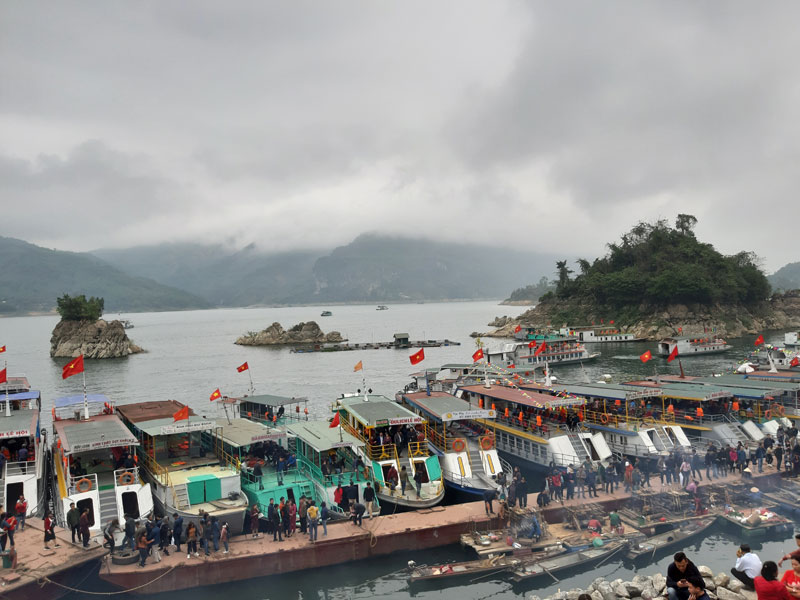
(HBO) - On August 1, 2016, the Prime Minister approved a master plan on the development of the Hoa Binh Lake National Tourism Site which serves as an important lever for disadvantaged areas along the lake to boost socio-economic development. After a long sleep, now Ngoi village in Suoi Hoa commune (Tan Lac district), Ke village in Hien Luong commune, Da Bia community tourism site in Tien Phong commune, and Sung village in Cao Son commune (Da Bac district) have became famous places on Vietnam's tourism map.
 A corner of Hoa Binh lake.
A corner of Hoa Binh lake.
Hoa Binh lake
has a surface area of about 9,000 ha and a capacity of about 9.45 billion cu.m,
spreading over the districts of Cao Phong, Da Bac, Tan Lac and Mai Chau and Hoa
Binh city. It is home to 47 islands, including 11 limestone ones covering an
area of about 116 hectares, and 36 mountainous land ones with a total area of
157.5 hectares. In addition, on Hoa Binh lake, there is a pristine and
mysterious karst cave system with multicolored stalactites like Thac Bo cave
and Hoa Tien cave. During all the four seasons, the lake water is clear and
green. Lying along the two banks are immense forests with rich flora.
Hamlets
of Muong, Thai and Dao ethnic groups dot Hoa Binh lake, where their diverse
cultural identities are being preserved. Ancient customs and traditions are expressed
through Muong folk songs, Mo Muong or special Muong gong performance. In addition,
the cuisine of the people here is rich, diverse and unique; and the craft of weaving
is passed down from generations to generations.
The
natural landscape mingled with the cultural identities of locals has created a
charming picture that can attract any visitor.
Bui Thi
Hieu, Vice Chairwoman of Da Bac District People's Committee, said that since
2014, the Australian Foundation for the Peoples of Asia and the Pacific (AFAP)
has supported four households in Ke village (Hien Luong commune) and Duc Phong village
(Tien Phong commune) in building and repairing houses, buying blankets, pillows
and cushions, and in training human resources, community tourism skills for
locals.
Before
2016, to support local people in developing their economy and improving their
living standards, the province had conducted a survey on potential of lakeside
communes to develop a tourism development project. The provincial Department of
Culture, Sports and Tourism had cooperated with other departments and agencies
to restore relic sites on Hoa Binh lake such as Bo temple in Cao Phong and Da
Bac districts, and Hoa Tien cave in Tan Lac district./.
A diverse chain of eco-tourism and resort destinations concentrated in Hoa Binh city and the districts of Tan Lac, Da Bac, and Luong Son… Along with the launch of several key high-quality resort tourism projects, these developments have reshaped the landscape and enhanced the appeal of Hoa Binh as a travel destination.
Boasting diverse terrain, a mild climate, and rich natural resources, Cao Phong district is increasingly asserting its place on Vietnam’s tourism map, attracting both domestic and foreign visitors. The district is renowned for its stunning landscapes, majestic mountains, a crystal-clear hydropower lake, and the unique cultural identity of local ethnic groups.
With its pristine landscapes, unique cultural heritage of Muong ethnic minority, and an expanding range of visitor experiences, Tan Lac district of Hoa Binh has fast become a captivating destination for both domestic and international tourists.
Until now, Sung village in Cao Son commune, Da Bac district remains the only Dao ethnic community in Hoa Binh province to develop a community-based tourism model. Beyond its untouched natural landscapes, cultural identity serves as the cornerstone attraction for visitors.
Alongside the diverse cultural identities of the Kinh, Muong, Tay, Thai, Dao, and Mong ethnic people, Hoa Binh province is also renowned as the "capital" of the northwestern Vietnamese cuisine, offering unique and distinctive dishes. At festivals, during Lunar New Year (Tet), or on significant family or community occasions, special dishes are prepared, leaving a lasting impression on visitors.
A Phong Linh (Yellow Tabebuia) flower garden in Thang village, Thach Yen commune, Cao Phong district is currently in full bloom, drawing a large number of visitors.



 A corner of Hoa Binh lake.
A corner of Hoa Binh lake.